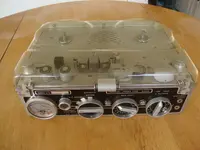T
tanoka
New member
Hi all,
Many years since I posted here. I'm building a hi-fi archival system for pre-war disc recordings, a good number that have never been re-issued in any format, surprising how 90 year old discs can be neglected so long! It's a bit of a daunting task but I'm getting very close to completing the front-end which will include three different turntables with six tonearms/carts to cover the wide range of groove widths used. I'll be using tube phono pre-amp equalization through a S.E.T. amp and a field coil speaker.
The one thing I haven't done much research on yet is finding the best possible r2r for my recordings. I'm guessing full track mono 1/4" at 7.5 and 15ips will be ideal. I know this forum's filled with very knowledge people so I appreciate advice.
I would want to purchase one fully restored as well, any leads on that would be great.
thanks,
Tenyu
Many years since I posted here. I'm building a hi-fi archival system for pre-war disc recordings, a good number that have never been re-issued in any format, surprising how 90 year old discs can be neglected so long! It's a bit of a daunting task but I'm getting very close to completing the front-end which will include three different turntables with six tonearms/carts to cover the wide range of groove widths used. I'll be using tube phono pre-amp equalization through a S.E.T. amp and a field coil speaker.
The one thing I haven't done much research on yet is finding the best possible r2r for my recordings. I'm guessing full track mono 1/4" at 7.5 and 15ips will be ideal. I know this forum's filled with very knowledge people so I appreciate advice.
I would want to purchase one fully restored as well, any leads on that would be great.
thanks,
Tenyu


